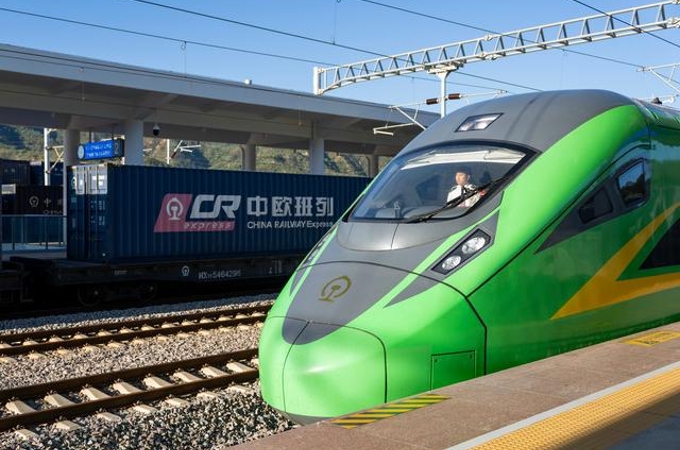AI assistant gives pathologists helping hand in cancer detection
Source: China Daily | 2024-12-26 | Editor:Ines
Artificial intelligence-enabled medical diagnostic tools are ensuring greater accuracy in cancer screening and detection, helping doctors arrive at more precise diagnoses and enhancing treatment quality.
Zhejiang University recently introduced an AI-powered universal pathology assistant called OmniPT, which integrates vision and language models for human-computer interaction. The model is being used at the First Affiliated Hospital of Zhejiang University School of Medicine's department of pathology, focusing on high-incidence cancers such as gastric, colorectal and cervical. The hospital in Hangzhou, the capital of Zhejiang province, is the first clinical institution in China to use an AI-powered pathology assistant.
OmniPT has achieved a number of breakthroughs in laboratory tests, including in cancer classification, grading, vascular and neural invasion identification and the discovery of markers that indicate the future course of the disease, the hospital said. Analyses and predictions by OmniPT have been 80 to 90 percent accurate across cancer types.
Most patients and their families are unfamiliar with the details of pathology examinations — work performed on tissue samples or cells in a lab, and pathologists generally do not interact directly with patients.
When biological samples from a patient are sent to a lab, experts go through an intense process to understand the pathological changes and the nature of the disease in the specimen at hand.
The role of the pathologist is to help reach an accurate diagnosis through the application of rigorous empirical standards. China, however, faces a severe shortage of pathology professionals.
"Many people may know that pediatricians are in short supply, but pathologists are even more rare. Currently, our country needs 150,000 to 200,000 pathologists, but there are only about 30,000 officially registered," said Zhang Jing, chair of the pathology department and vice-president of the Yuhang branch of the hospital.
Apart from this massive gap, there are also regional imbalances. While cities like Beijing, Shanghai and Hangzhou may be facing less severe shortages, the situation is dire in remote areas, he added.
Additionally, the long training period only complicates the situation as young pathologists often lack the required depth of experience.
Against this backdrop, OmniPT, developed by Professor Song Mingli's team from Zhejiang University's College of Computer Science and Technology in collaboration with the First Affiliated Hospital, is facilitating fast, accurate clinical diagnosis.
By leveraging human-computer interaction and centering on the needs of pathologists, OmniPT significantly improves diagnostic efficiency and quality, and helps alleviate the shortage of professionals.
"It serves as an assistant to pathologists by handling repetitive tasks so that they can focus on final judgment," Zhang said.
He provided an example of counting mitosis, which is a critical task when diagnosing gliomas, a kind of tumor that can be found in the brain or spinal cord.
"It can take at least 30 minutes to an hour to count a single pathology slide under a high-power microscope," he said.
"OmniPT, however, can complete this task in less than 10 seconds. Its computational capabilities allow it to analyze the findings in far greater detail than manual work. When it encounters 10 uncertain mitotic figures, it reports to a pathologist like me to make the final judgment," Zhang added.
In collaboration with the hospital, Song's team has focused on clinical needs. OmniPT accelerates the evaluation of samples on slides, particularly details that might be overlooked by fatigued doctors. OmniPT handles more than 90 percent of repetitive tasks, leaving only a small fraction for pathologists to assess.
"It assists us, but it doesn't drive us. We drive it. By leveraging AI in our interactions, we can solve challenging problems in pathology — particularly for people in remote regions or those with less experienced doctors. It greatly improves efficiency, reduces costs and helps us avoid errors," Zhang said.
You May Like
-
Airdrops of food in Gaza a display of hypocrisy
On Saturday, the US military began dropping food over the war-torn Gaza Strip where 2 million people have been in desperate need of humanitarian aid.
InKunming 2024-03-04 -
Chinese C919 passenger plane debuts Singapore Airshow
Chinese passenger jet C919 debuted in a flight demonstration at the Singapore Airshow, which kicked off on Tuesday.
InKunming 2024-02-22 -
Airbus forecasts China to be world's largest aviation servic...
China will become the world's largest aviation services market by 2042, with its market value climbing to 54.1 billion U.S. dollars, Airbus China forecast on Tu...
InKunming 2023-12-13 -
Economic Watch: Airbus final assembly line in Tianjin witnes...
With the completion of the layout of the new plants, the preparation work for the second line of the Airbus A320 Final Assembly Line Asia (FALA) in north China'...
InKunming 2023-09-14 -
Feature: Air Silk Road connects dreams and hearts
Kiplagat Kenneth Kiptoo, a young man from Kenya, took a flight in May for east China's Hangzhou city, where he would pursue a bachelor's degree in intelligent m...
InKunming 2023-07-13 -
Air cargo route links China's Nanjing, Bangladesh
A cargo plane loaded with 17.6 tonnes of textile products recently flew from Nanjing, capital of east China's Jiangsu Province, to Bangladesh's capital Dhaka, t...
InKunming 2023-06-12 -
Come to Ailao Mountain to cook wildflower dishes
In Yunnan, a plate of wildflowers is an indispensable delicacy in spring, especially in Ailao Mountain with its beautiful natural scenery and different kinds of...
InKunming 2023-04-07 -
Airlines' awaited C919 makes test flight
The first C919 large passenger jet intended to enter service with China Eastern Airlines completed its debut test flight in Shanghai on Saturday, bringing the o...
InKunming 2022-05-16 -
Interview: China steps up fight against illegal wildlife tra...
China has been doing a good job in tackling the illegal trade of wildlife, the CEO of WildAid said, while the conservation group will continue to count on Chine...
InKunming 2021-06-11 -
Air route between southwest China, Bangkok resumes
An air route linking Kunming, capital of southwest China's Yunnan Province, and Bangkok, capital of Thailand, resumed operations on Thursday after almost a year...
InKunming 2021-01-15







